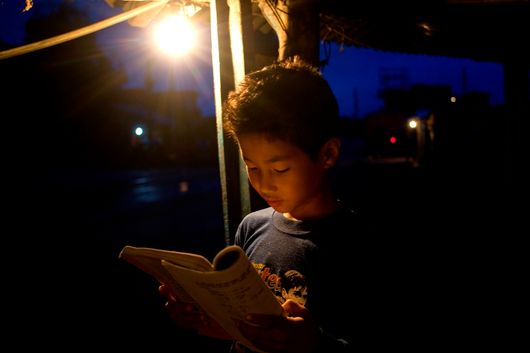The Patatas – An Education Solutions Consultancy
Education for Refugees: Barriers and Improvements in access

Source
Part and parcel of lives in the developed world, refugee camps face troubles in obtaining stable electricity supplies. Given how far refugee camps tend to be from city centres, being connected from local grids to the camps is very expensive due to the pre-existing lack of infrastructure to support electrical poles or wires. As everything has to be built from scratch, the process is long and costly; even when it is done, the distance causes disruptions to supply. As such, the power often gets cut sporadically, leaving the camp in complete darkness at night. The United Nations have come up with alternative internal electricity supplies like diesel generators and solar panels but these are too costly and polluting or unstable respectively. This has taken its toll on allowing the refugees access to education. Classroom lighting is dim or reliant on sunlight and research has shown that this affects learning, cutting refugees off from a quality education. Furthermore, as nights are often pitch black, it is dangerous for children to be out late and besides, learning cannot take place in the dark either as no one can see. Students are confined to times when the sun is out to learn or do their homework. In fact, the reason why so many refugee children fail to complete their education, causing the low enrolment numbers, is because they cannot finish their homework at night and cannot take time to understand what they are taught. This is made worse by how they could use their phones (should they have one) to find answers or watch educational videos online but may not be able to in times of power cuts. Phones cannot be charged during these times and understandably, any battery life will be saved for emergencies. Therefore, refugees are at a loss in these cases as education is completely inaccessible and there are no alternatives to go to, all because electricity is unstable.
The Patatas has come up with a solution to the barriers preventing young refugees from accessing education – CaseStudy. Basically, it is a briefcase packed with customizable audio-visual materials essential for conducting classes in refugee camps. Here are its qualities:

While still retaining the appearance and thus, portability of a briefcase, we have designed CaseStudy to be hardy enough to endure harsh weather conditions. Especially in regions which suffer frequent natural disasters, the strength of CaseStudy’s material is perfect for keeping classroom equipment safe and usable regardless of the conditions faced.
The equipment provided in CaseStudy constitutes technologies and their required accessories to provide the best modern classroom experience possible despite the barriers aforementioned. Even without stable electricity, Internet or digital devices, us here at The Patatas have thoughtfully put together a combination of elements that require none of this. We have ensured to keep the limitations faced in mind while helping these young refugees experience the use of relevant technology from a young age. In our digital era, it is crucial they develop media literacy skills and know-how to utilise such devices on top of their usual curriculum to keep their knowledge relevant to the times. Let’s explore its contents! Firstly, we have the Raspberry Pi, a small-sized computer used to store pre-loaded educational resources in. With the variety and number of files (about 8GB) that can be stored within it, education for refugees is just a few clicks away at all times. It costs around $50 less than normal tablets and teachers simply need to connect it to a projector and speakers to allow its resources to be fully available to their classes. Since everything is already in the Raspberry Pi, the Internet is not required to access digital educational resources. It also does not require constant electricity supply, seeing as it uses a portable charger and thus, does not need to be plugged in. Even better, should the teacher see fit for the purposes of their class, the contents of each Raspberry Pi can also be easily customized, teachers can load different files into it depending on their teaching style and their classes’ learning style. Secondly, a portable projector has been included to help project the educational contents for the children to see clearly.

Like the Raspberry Pi, it comes with a portable charger or alternatively, a battery to power it. In the same vein, this means a power supply is no longer necessary for classes. Besides, projectors require dim lighting to work which caters perfectly to the unstable electricity supply at camps. Personal digital devices are also not required as the projector disseminates information for everyone in the room to see. Thirdly, speakers are also provided to display audio/ audio-visual material effectively. With no need for power supply or the Internet to use, speakers will provide classes with the full education experience using technology. Lastly, we included any other accessories needed to operate the above materials.

